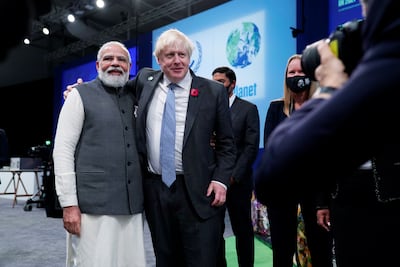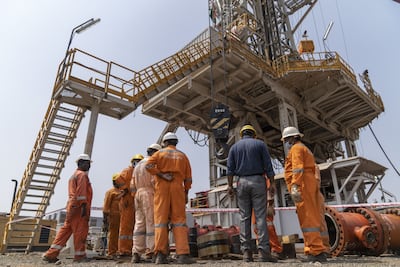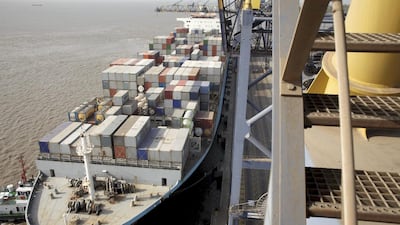As global economic power continues to shift eastward, India's position as the world's sixth-largest economy – behind the US, China, Japan, Germany and the UK – is projected to improve in the coming decades. According to the accounting firm PricewaterhouseCoopers, it is expected to surpass America to become the second-largest economy by 2050, behind a newly arisen China.
India's energy consumption quite naturally will grow even further during this period – but there's a catch. With climate mitigation needing to be factored into policymaking, how the country manages its energy transition will be keenly watched by producers around the globe, particularly the Gulf countries, who have had decades-long close ties with the subcontinent.
There is indeed some uncertainty about how quickly the transition will occur.
Looking at the forecasts made by the energy giant Shell, as well as the Energy and Resources Institute in New Delhi, one can only make some cautious guesses, even considering the unpredictability of global energy, financial and other markets. The country's complex political and economic systems have so far forced the government to take a more prudent approach in its climate fight.
In the run-up to last year's Cop26 climate conference, for instance, the widespread belief was that New Delhi would be able to commit itself to a net-zero emissions target by 2050. That it chose a more conservative timeframe – of 2070 – reflects the challenges of making this transition. In fact, 2080 seems a more reasonable benchmark.
The country has already begun reforms across a wide swathe of industry, such as fast-tracking the use of hydrogen in the globally critical iron and steel sector, as well as in other heavy industries. There is a desire to increase carbon capture, storage and utilisation. A concerted effort is being made at various levels to transition to biofuels, raise energy efficiency and lower energy use in new buildings. Reforestation efforts are under way. There is also a growing appreciation for nuclear energy as a low-emission source of electricity.
More needs to be done across the board, however, from increasing the overall capacity to generate solar energy to reducing coal consumption to electrifying farm equipment – and, eventually, ending the sale of internal combustion engines.
How, then, will all this affect the GCC's energy relations with India?
Given its geographical proximity and robust relationships, it is unsurprising that the country imports 35 per cent of its crude oil from the Gulf. This is unlikely to change in the short term. In the medium term, India may lean even more on the region, despite recent discussions about importing more oil from Russia.
Indeed, India's oil demand is likely to grow from five million barrels a day today to about 8.7m by 2040. Demand for LNG is set to rise four times, to more than 124 billion cubic metres per year during this period. Its overall natural gas demand is projected to increase from 61bn cubic metres per year to about 200bn cubic metres. Currently, India gets 55 per cent of its LNG from the GCC and one can expect those energy relations to continue.

The reason for this is simple: as part of the early stages of its transition, India is seeking to replace coal with natural gas. Policymakers have determined that LNG supply needs to be ramped up in the medium term before it can be brought down in the longer term, at which point it is hoped that India will have adequately developed its renewable energy sector. New Delhi has begun domestic exploration for LNG, but to meet the burgeoning demand, it will remain reliant on overseas supply. The Gulf countries will be smart to bridge this gap as swiftly as possible – especially if the 2015 Iran nuclear deal is revived following which that country may be reintegrated into the global economy and allowed to sell its energy to the world. Russia, too, is a potential LNG source for India.
It’s the same with oil. Aside from the Gulf, India imports large quantities from Angola, Mexico, Nigeria, the US and Venezuela. But with extraction being more expensive in these countries, India will depend ever more on the GCC. After all, as global oil markets begin to decline because of the worldwide energy transition currently under way, it is those producers that are able to get the oil out of the ground at lower prices that will remain competitive.
History has taught us that Gulf-South Asia ties have always evolved with the changing times. That’s likely to be the case even in the latter stages of their respective energy transitions. In fact, they are already finding new avenues for co-operation.
A peek into the future suggests there is much that India and the GCC can learn from one another's transition strategies. Collaborations are possible in a range of areas from green finance to green inventions and innovation to circular carbon economies. With India seeking to move away from coal and the GCC building a post-oil future, expect more joint investments in hydrogen energy and related technologies.

Gulf-based research institutes and think tanks, such as Masdar Institute in Abu Dhabi and the Riyadh-based King Abdullah Petroleum Studies and Research Centre, may find it useful to work with their Indian counterparts. There is potential for university-level collaborations on research and development of energy-related technologies. Indian labour and expertise can help GCC countries with their greening efforts. In turn, GCC expertise, finance and other capabilities will come in handy for India.
There is, of course, no doubt that change will bring with it its share of challenges.
South Asian countries will need to carefully consider the impact of transitioning on their individual energy, water, food, economic and human resource requirements. Just like everyone else, they will also need to prepare for occasional energy shocks.
A country as large as India's will be mindful of the possible employment-related challenges that are bound to spring up, as some old jobs become redundant. It will need to invest heavily into retraining its huge population, so that they are ready to take up new jobs. Here, too, the GCC can play an important role through financing and its world-class educational institutions.
There is already a lot riding on the two regions' collective stability – the GCC has a combined GDP of $1.4 trillion, while India's is about $2.9tn – and proactively managing headwinds together will be critical for them to continue growing.
Given all this, it makes perfect sense for both entities to continue working together towards a mutually beneficial future.



